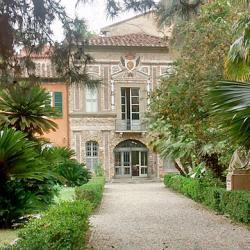
Place:
Pisa
Start date:
End date:
The appointment returns with the discovery of the most hidden places of Italian cultural heritage. Saturday 24 and Sunday, March 25, the hour of the FAI Spring Days, reached the 26th edition, with thousands of places open all over Italy.
"When in 1993 the first edition of the FAI Spring Days took place (50 places open to the public in about thirty cities) it was difficult to imagine that they would become one of the most important events in the Italian cultural scene - underlined by the Italian Environment Fund - in 25 years our volunteers have opened over 11,000 places in 4,700 cities and we have involved over 35,000 'ciceroni apprentices', middle and high school students who accompany the visits ". "The FAI Days have therefore become a coveted appointment, a national event of great attraction, but they have not lost the original spirit - they continue - to accompany the Italians to discover or rediscover the beauty that surrounds them, which often goes unnoticed or worse, it is forgotten and disfigured.For this, the FAI Days of Spring and Autumn have one destiny: to become bigger and bigger, more alive and lived, to bring more people closer to the beauty of art, of culture and history ".
For information: www.fondoambiente.it
Naturally, also in the province of Pisa it will be possible to visit some places that will be open to the public during the weekend: here are some of them.
Barrel under the Arno in San Giovanni alla Vena (Vicopisano)
Schedule
Saturday: 9.30am - 12.30pm (last admission at 12:00)
Sunday: 9:30 am - 1:00 pm - 3:00 pm - 6:00 pm (last admission 5:30 pm)
Attention: in case of large turnout the entrances could be suspended before the indicated closing time.
Suggested contribution starting from: € 3.00
In 1852 Grand Duke Leopold II approved the project of Alessandro Manetti for the drainage of Lake Bientina, which provided for the deviation of the Imperial Canal built about a century before by the Ximenes. The thus diverted emissary had to pass under the Arno by means of a so-called 'barrel', that is a 250 meter long underground conduit. The first stone of this extraordinary work of hydraulic engineering was laid in 1854. The Grand Duke was so impressed by the work that he described the various construction phases in his Family Government. Even today it is possible to admire its fully functional structure. For the FAI Members there will be an external visit with the 'apprentices ciceroni' of the scientific high school 'XXV Aprile' of Pontedera and of the cultural association 'There is no future without memory'. Concurrently, an exhibition will be set up in the Palazzo Pretorio di Vicopisano with an original model recently discovered.
Botanical Garden in Pisa
Schedule
Saturday: 9:30 am - 1:00 pm - 2:00 pm - 5:00 pm (last entrance 16:30)
Sunday: 09:30 - 13:00 - 14:00 - 17:00 (last entrance 16:30)
Attention: in case of large turnout the entrances could be suspended before the indicated closing time
The guided tours will start from the entrance of via Luca Ghini, 13.
Suggested contribution starting from: € 3.00
The botanical gardens, university structures for scientific research, were born in Italy in 1500, the first examples of spaces to support investigations in the medical and pharmaceutical fields. The Garden of Pisa was founded in 1544 on the initiative of Luca Ghini, Imola doctor-botanist, and thanks to the funding of Cosimo I dei Medici. With the Garden, therefore, Ghini introduced a great novelty at an educational and scientific level that consisted in the didactic use of fresh plants, shown and discussed not only for therapeutic properties but also for their identity and nomenclature. The first Garden of Pisa was located in the area of the vallum at the Citadel then, in 1563 in a land in the northeastern area of the city near Calcesana gate and finally in the current headquarters of Via Santa Maria by will of Ferdinando I. Today's structure of the The vegetable garden is very different from the original one due to changes and expansions over the centuries, the latest in the tropical greenhouse.
Visitors will be accompanied by the 'ciceroni apprentices' of the 'Pacinotti' institute of Pisa.
Palazzo Quaratesi in Pisa
Schedule
Saturday: 10:00 - 13:00 - 14:00 - 17:00 (last entrance 16:30)
Sunday: 10:00 am - 1:00 pm - 2:00 pm - 5:00 pm (last entrance 16:30)
Attention: in case of large turnout the entrances could be suspended before the indicated closing time
Suggested contribution starting from: € 3.00
For the first time, the Quaratesi palace, located in via Santa Maria, connects the Piazza del Duomo with the Lungarno Pacinotti. Wanted by the Grand Duke Ferdinando I, it was built from scratch, on a drawing of the sculptures and architect Pietro Francavilla between 1593 and 1597 to house the Pia Casa di Misericordia, an ancient Pisan institution. Soon the palace changed its destination and became a dwelling inhabited by more noble families: the Marracci, the Curini, the Galletti, to pass in 1928 to the Florentine family of the Marquis Quaratesi D'Achiardi. On the occasion of the wedding between Iacopo Curini and Maddalena Galletti, between 1730 and 1740, the painter Gian Domenico Ferretti frescoed the vault of the salon with the emperor Justinian who dictates le Pandette, the subject chosen to honor Antonio and Biagio Curini eminent characters of the Studio Pisa. The vault is further embellished by the rococo stuccoes by Giovanni Frullani. Since 2015 the building houses the Academy of Fine Arts. The 'ciceroni apprentisti' will be the students of the classical high school "Galilei" of Pisa, the artistic high school "Russoli" of Pisa and the international high school "Pesenti" of Cascina.